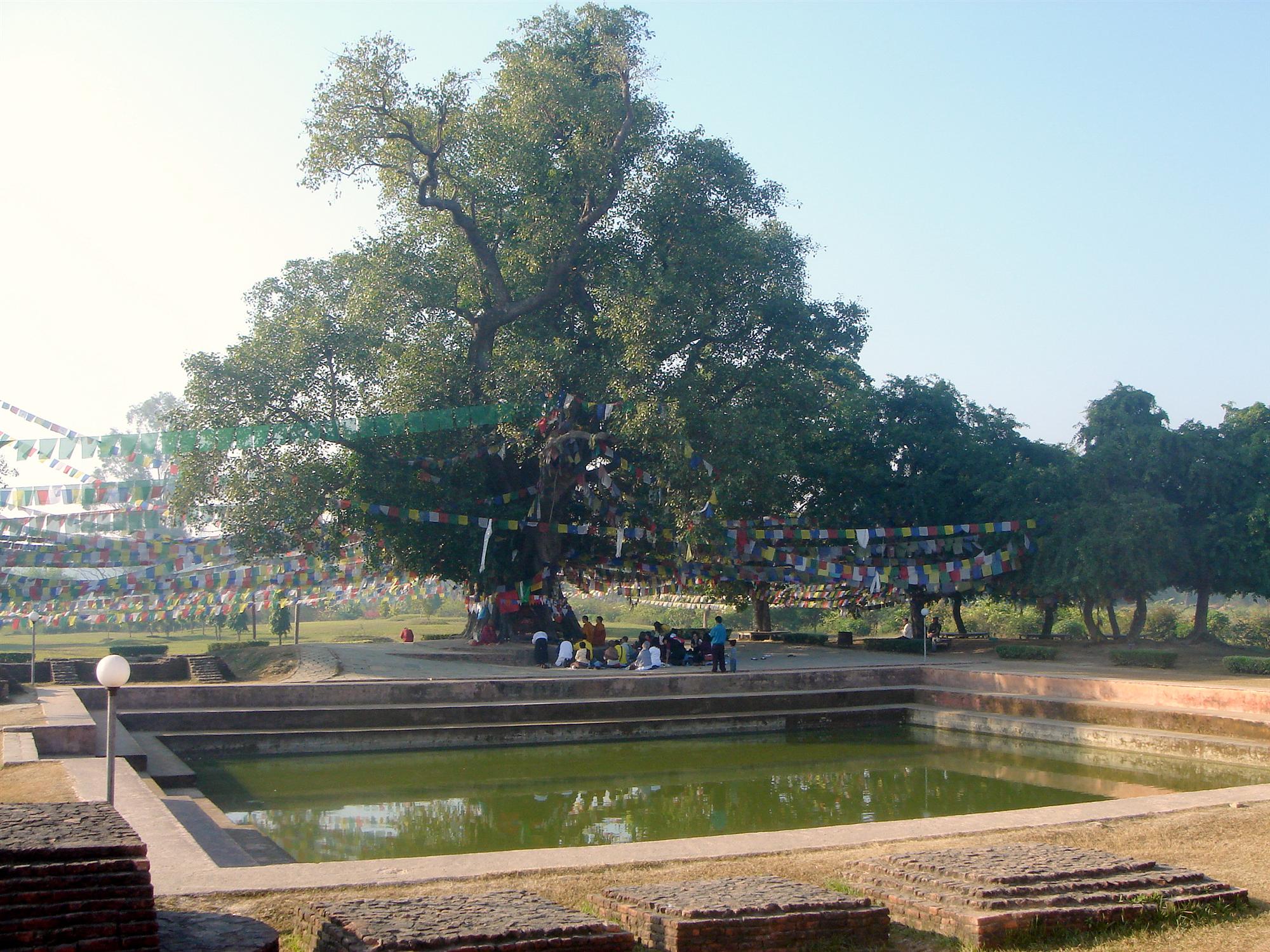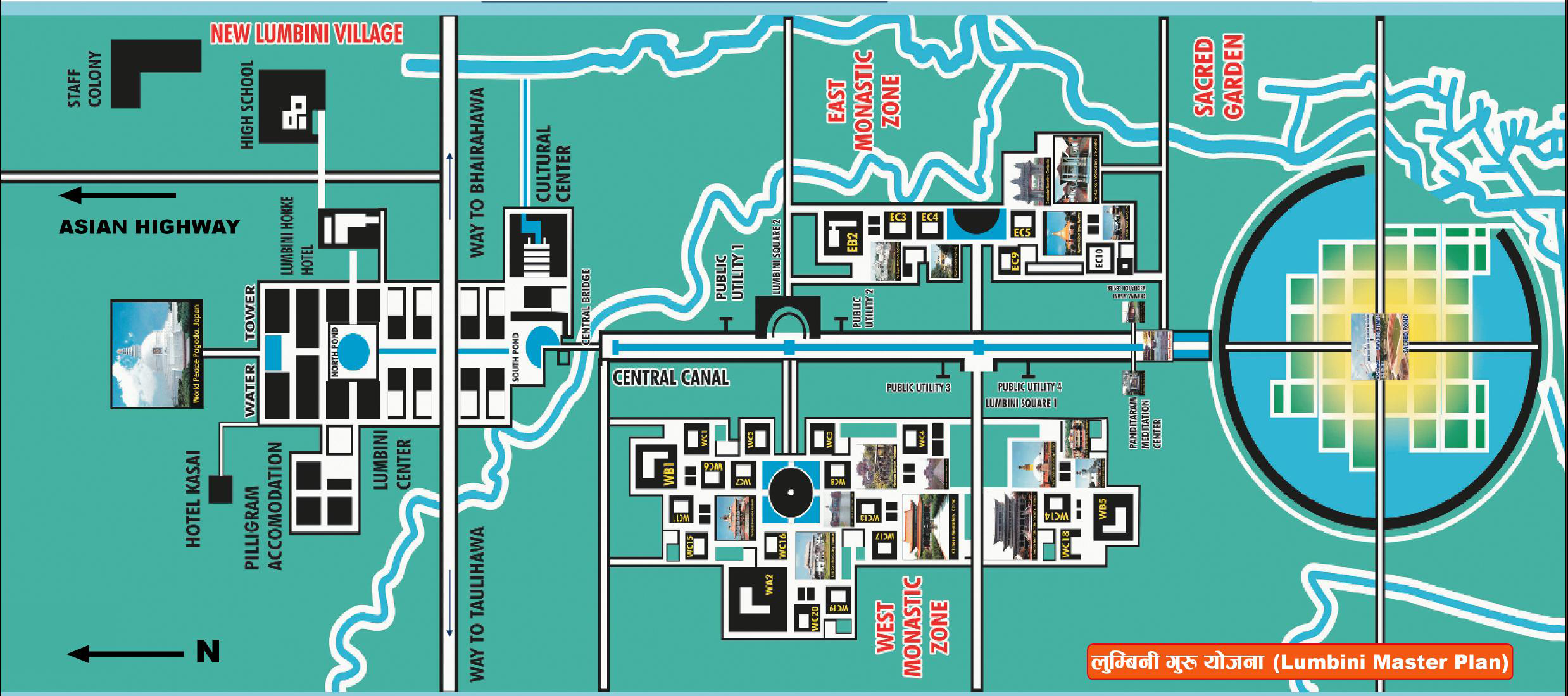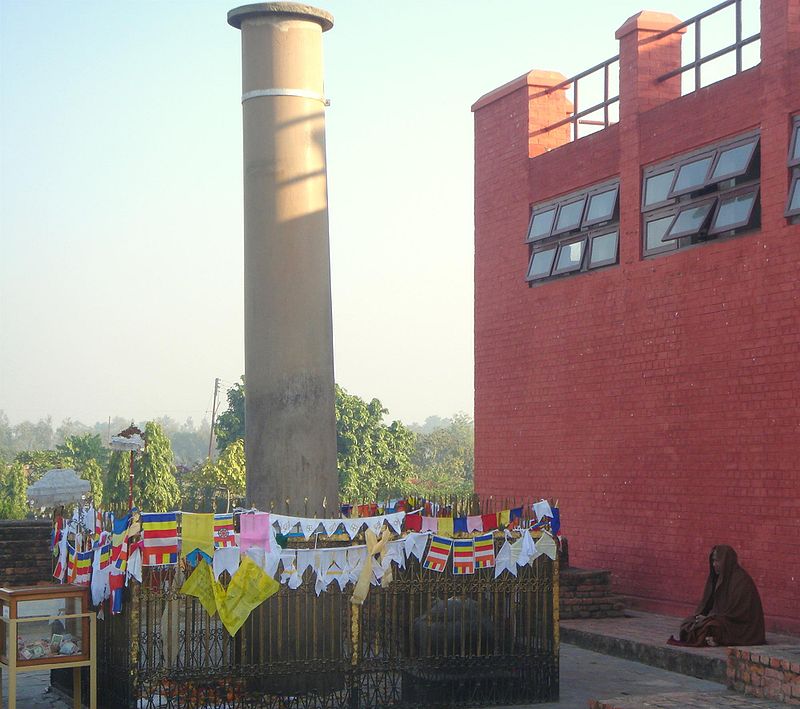Description and Short History
Lumbini is the birthplace of Siddhartha Gautama, known as the Buddha. In the Buddha’s time, Lumbini was in the state of Kosala where the Gautama family of the Sakya clan had lived. It was recorded that the Buddha’s mother, Maya, gave birth to her son in the park of Lumbini near Kapilavastu (Mitchell & Jacoby, 9). Lumbini is located in the Rupandehi District of Nepal, on the border between Southwest Nepal and India (Planet Web Nepal).
The site has become sacred after the Buddha established Buddhism. It is bound by monastic areas, has a length of 4.8km and a width of 1.6km. The Theravada monasteries are in the eastern zone, while Mahayana and Vajrayana monasteries are in the western zone. The main constituents of the holy site consist of remains of ancient monasteries, a holy Bodhi tree, an ancient bathing pond, the Ashokan pillar and the Maya Devi Temple (Planet Web Nepal)

Figure 2: The Bodhi Tree and the Bathing Pond. Unknown author. en.wikipedia.org/wiki/Lumbini 07 Dec. 2015.
The Bodhi tree represents the one in Bodhgaya under which the Buddha sat when he attained Enlightenment and Awakening. The bathing pond is where the Buddha’s mother, Maya, took a bath before giving birth to the Buddha (Planet Web Nepal).
The Ashokan pillar is 6 meters tall and is made of pink sandstone. It was built by the Mauyan Emperor Ashoka in 249 BC. The inscription on the pillar recalls Ashoka’s visit to the Buddha’s birthplace after he became a Buddhist. The inscription reads:
“King Piyadasi (Ashoka), beloved of devas, in the 20th year of the coronation, himself made a royal visit, Buddha Sakyamuni having been born here; a stone railing was built and a stone pillar erected to the Bhagavan having been born here, Lumbini village was taxed reduced and entitled to the eight part (only)” (The Longest Way Home).
The pillar was rediscovered by a German archaeologist named Führer, beside ruins of the Mahadevi temple. It was moved to its original place beside the temple by the governor of Palpa, Khadga Shumsher Rana, in 1896 (The Longest Way Home). Out of the only 19 pillars remaining that have inscriptions on them, the one in Lumbini is the oldest inscription found in Nepal (The Longest Way Home).
The Maya Devi Temple, also known as the Lumbini temple, shows the place where the Buddha, Siddhartha Gautama, was born. The temple is on the opposite of a holy pool (known as Puskarni) and a holy garden. The remains of the temple were found by archaeologists, who found out it was built by Emperor Ashoka in the third-century BCE. In November 2013, the remains of an ancient tree shrine dated before 550 BCE were also found. These were the earliest evidence of Buddhism and the Buddha’s life, as it is said that Siddhartha Gautama was born under a sal tree which Maya used to support herself while giving birth to her son (Monte). There is a marker inside the temple that marks the exact spot where Buddha’s mother, Maya Devi, gave birth.
When the Buddha told his followers that one of the important places in his life was Lumbini, the place became an important site for early Buddhists. As recorded on Emperor Ashoka’s pillar, many famous Chinese monks have paid their visits to the holy place, the most famous ones being Faxian and Xuanzang (Weise, 44). Faxian and Xuanzang have both written an account of their visit to Lumbini in their journals, which helped to spread Buddhism, as well as the significance of this place, to other countries. Since Lumbini represents the birth place of the Buddha, as well as that of Buddhism, early Buddhists came to the place hoping to attain spiritual purity. The site then became increasingly significant for Buddhist faith.
The last visitor recorded on the pillar was Prince Ripu Malla of the Nagaraja Dynasty of western Nepal. He made an inscription on the pillar that contains a praise for himself, as well as a mantra (Weise, 54). The place has been damaged and got quite forgotten due to possible religious conflicts and natural disasters after Prince Malla’s visit, and finally got rediscovered in the 19th century (Weise, 54).
Lumbini Today
After its rediscovery, Lumbini was declared a UNESCO (United Nations Educational, Scientific and Cultural Organization) World Heritage Site in 1997 (Weise, 73). After reconstructing the site, the UNESCO has launched several projects together with the United Nations for the conservation and development of Lumbini. Although the purpose of the projects aimed for the protection and conservation of Lumbini’s religious values, it is inevitable that the reconstruction of the site has resulted in turning it into an attraction for tourists and pilgrims from around the world. Today, the sacred site of Lumbini has been developed into a Buddhist pilgrimage centre, with the central feature being the archaeological remains that prove the truth of the Buddha’s birth (UNESCO).
The representation of Lumbini has been changing over the years. While Buddhists still come for spiritual purposes, non-Buddhist locals see the place more as an economic resource, and the government uses the site to enhance national cultural pride and international support, as well as making profit out of tourism. The number of foreign tourists is about 71,000, while the number of local and Indian tourists is about 400,000 every year (Nyaupane). There is no doubt that the growth of tourism benefits the country in terms of economy, employment, as well as national pride. However, as the government of Nepal has been placing more emphasis on attracting tourists, Lumbini now seems to have lost some of its religious symbolism.
“Tourism plays an important role in Nepalese economy, particularly in terms of foreign exchange earnings and employment creation” (H.E.Thosapala Hewage, Ambassador of Sri Lanka to Nepal, 2010).
Religious and cultural tourism are one of the different types of tourism that benefit Nepal in terms of profit making. Lumbini, as the birthplace of the Buddha, stands for the most important evidence of the Buddha’s birth. The holiness of the place, which is supposed to provide spiritual renewal to its visitors, has been used by the government as a tool to attract tourists. The Master Plan was established in 1978 by a Japanese architect Professor Kenzo Tange to develop Lumbini into an international pilgrimage and tourist centre. The idea is to build more monasteries representing different types of Buddhism, improve the infrastructure of the sacred space and give it “an atmosphere of spirituality, peace, universal brotherhood and nonviolence consistent with the time and Buddha’s message to the world” (Planetwebnepal). In addition, the plan is interested in developing the cultural side, as well as the “New Lumbini Village”, which is intended to offer restaurants and hotels for the visitors. The project is still on-going, after having been accepted in 1985 (Plantwebnepal). Later, the Lumbini Development Trust was estabilished for the overall management of Lumbini’s development (Tiwari).
Concerning the motivation of visitors, 60% came to Lumbini because of their interest in Buddhism and their wish to physically see the place of the Buddha’s birth (Acharya). This shows how Lumbini is losing its religious pureness, therefore turning into a place where people visit out of mere touristic interest, while the government economically benefits from it.
Furthermore, the government of Nepal has decided to develop Lumbini into a place where tourists can not only come to visit, but also to stay for a few days. As the site is quite small, many tourists set Lumbini as one of the many destinations of their trip, and do not wish to stay there longer. They often take a quick glance of the site before moving onto other attractions. Therefore, the government has planned on building and renovating hotels around the site in order to keep the visitors for a longer period of time. Moreover, local facilities such as transport, communication, water, electricity and infrastructures need further improvement in order to cater to the demands of tourists. Other existing infrastructures such as the Lumbini University, the Lumbini International Research Institute and Lumbini Museum are used as additional attractions (Shrestha). This shows that the places of interest do not only revolve around the Buddha’s birthplace anymore, but expand to Lumbini as a whole. In addition, the King, the Prime Minister, and the Minister Nepal also have the intention to develop Lumbini into a great touristic place, which shows that the major national figure understand the significance of Lumbini as a religious site having great potential in terms of profit making (Shrestha).
Moreover, the monasteries and temples built around the region are also becoming a centre of interest themselves. There are different monasteries representing different Buddhist countries and traditions, from Thailand, Myanmar, Cambodia, Japan, China, South Korea, Vietnam, as well as meditations centers and sanctuaries (Planetwebnepal). Those places also help to promote Buddhism, as well as add to the significance of the religious site, since they can be used as attractions for the visitors.
It is obvious that the status of Lumbini has changed over the years. During the establishment of Buddhism, Lumbini was seen as one of the most important Buddhist sites for faithful followers, as they were able to attain spiritual renewal at the Buddha’s birthplace. Very few foreign visitors were able to reach the place due to lack of transport and accessibility. Today, although Lumbini is only starting to develop, it has become a famous Buddhist destination, thus the government and different international organizations are getting interested in investing in this site. It no longer represents a purely religious sacred site, but more a place of cultural interest and a contributor to the country’s economic growth. As it has been evidenced above, the purpose of reconstruction and preservation of the religious values have been transforming the site into a governmental development, where the aim is mainly to attract more tourists.


